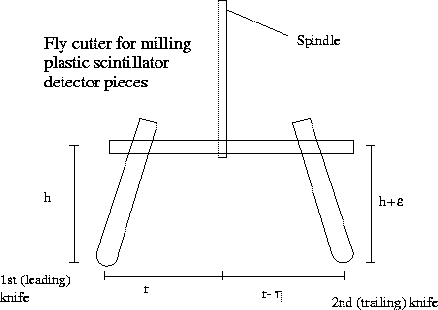
Folks at Bicron practice a form of milling of plastic scintillator surfaces that leaves a surface typically flatter and smoother than hand-polished surfaces. They have developed over time a method of milling that uses diamond edge fly cutters. We at UVa have adapted this method with great success using non-diamond regular fly cutters. Apparently the diamond tips ensure a more reproducible surface over a longer period, which may matter on larger jobs. We believe that using a carbide tip cutter should give comparable results. At UVa we have used regular machine tool steel cutters with excellent results for smaller and medium-sized jobs.
The setup of the fly cutter is schematically shown in the figure below:

Please note that the first (leading) knife cuts slightly shallower than the second (finishing) knife, by a small amount denoted in the figure as \epsilon (I don't know how to make html show Greek letters gracefully, D.P.). The second knife is shown to trail the first knife by another small quantity, \eta. Tuning these parameters takes a little practice, so it is best to take a sample piece of scintillator material to be machined and work on it until satisfactory results are achieved.
Another helpful hint is to try and make the radius of curvature of the second blade slightly bigger than that of the first blade. In this way the second ``groove'' is a bit flatter than the first one and results in a smoother surface.
Dinko Pocanic, 28 January 1999.